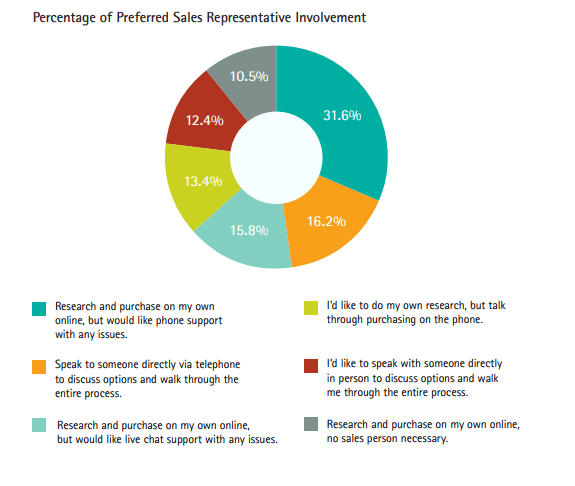How to overcome unique B2B digital marketing challenges
Contributor Stoney deGeyter understands that folks marketing a B2B business have unique requirements. Here are several ways to overcome common obstacles and attract business.

When it comes to business-to-business (B2B) marketing, anyone who has been operating in the space understands it comes with a particular set of challenges.
Unlike marketing to consumers, B2B companies often have to deal with longer sales cycles, smaller audience markets, and higher ticket prices. In addition, they must first generate leads to follow up on as opposed to selling a product directly.
This makes B2B marketing challenging. While I can’t cover every challenge you may face in your B2B marketing efforts, let’s look at some common obstacles you may be facing and how you can overcome them to grow your business.
Embrace digital marketing
If you’re reading this article, you may have already embraced digital marketing as part of your business growth efforts.
Or maybe you’re still trying to understand if digital marketing is right for you. After all, business has always been good and you have plenty of new and existing customers to keep you busy. So why go all-in on digital marketing?
Truth be told, the old way of face-to-face marketing and sales is quickly becoming obsolete.
According to a 2014 Accenture study, only 12.4% of buyers want to meet with a sales representative in person or even over the phone. A significant majority (71%) prefer to perform online research, with or without the help of a salesperson.

A handful of questions for B2Bs looking to maintain or earn their digital authority might be:
- Are you going to become a destination for research or let searchers land on your competitors’ websites?
- Are you going to let someone else educate the buyers, thereby earning their trust, or
- Will you be the one at the forefront of answering questions and providing value that walks researchers into a sale?
Digital marketing is cutting down a lot of the lead time it takes to close the deal. It may not eliminate it completely, but it is helping buyers become more informed than ever. Becoming an online authority in your niche opens up new opportunities for branding and, ultimately, proving your value long before buyers are ready to reach out.
Content production
In the digital age, we are all publishers. I often make this point when speaking to other businesses about digital marketing, and illustrate it using the image below.

Not until the last few years were any of the companies above known as content producers.
Netflix and American Movie Classics (AMC) started by broadcasting shows and movies from other studios, now they’re both powerhouses in their prospective areas. And even though no one really thinks of Red Bull or Chipotle as content producers, they have both been active in creating entertaining content.
You don’t have to try to compete with any of these companies when it comes to content, but you do need to get into the content-creation mindset which is not easy.
Plan ahead
The trick is to plan ahead. Sit down with your team and map out content ideas for the next four to twelve months, then determine the best format for each piece of content. Consider text, images, video and social media in your planning process.
Most B2B businesses get stuck on content due to the amount of time it takes to produce. Unfortunately, there’s no shortcut here, but if you plan, schedule and put the right people in charge, your content production will increase in quantity and value over time.
Planning is half of the content creation battle, once you have a plan in place, make assignments and stick to deadlines.
Understand conversion values
In ecommerce, the conversion is the sale. But most B2B businesses don’t have the luxury of selling products directly. Instead, they must manage leads from a variety of conversion points on their website.
In fact, any B2B website will range from one or more “conversion” points, they can range from:
- Contact form being submitted.
- A phone call.
- A question being submitted about your solutions.
- A download of a brochure, whitepaper, or ebook.
- A visit to a particular page on your website.
Each one of these conversions has a different value based on the likelihood of it turning into an actual customer. When looking at your online conversion data, it’s important to differentiate between each of these conversions points.
If your digital marketing team is touting a growth in conversions but your sales are not following suit, it may be because they have lumped all their conversions into the same bucket. While you can’t fault them for showing the improvements they have achieved, you do want to make sure they are focused on the conversions that have the highest value to your business.
Manage expectations
Digital marketing itself is a long-term play. While a site can be optimized within a definitive amount of time, it’s the building up of your digital authority that takes time.
This makes digital marketing a challenge for many who expect to see quick results. I tell most people you’re looking at nine to twelve months before you really feel like your digital marketing strategy is paying dividends.
But with the long sales cycle of B2B, it’s even more important to manage expectations. Not only do you have to bide your time while you build up your digital authority, you then have the added delay of the time it takes to convert your leads into actual customers.
The good news is that with analytics in place, you can start tracking metrics that prove whether or not the digital marketing strategy is working.
As you build your online authority and optimize your website, you should begin to see a rise in the metrics and then traffic. This will be followed by an increase in the low-value leads, followed by an increase in the high-value leads.
Ultimately, you want more of those high-value leads that you can convert into customers, but it often takes more of the former to get the latter.
When you see traffic increase but you don’t see an increase in leads, remember, many searchers are doing research first. That means a potential customer may come back to your site one or more times before they reach out.
Ultimately, you want to get results as quickly as possible. But having unrealistic expectations in regard to the already long timeframes that are a part of digital marketing, as well as B2B marketing, will only lead to frustration and potentially bailing out on a campaign before it has a chance to succeed.
Overcome and survive
If you’re frustrated with the challenges your B2B business faces, you’re not alone.
Think of digital marketing as unclaimed land, there is a lot out there, and sooner or later someone is going to stake their claim. As the digital landscape grows and the non-digital landscape shrinks, you’re going to need some digital real estate to survive.
No matter what avenues you go to for new business, there will be challenges. Are the digital marketing challenges any greater than the others? Maybe. But if the challenge is greater, so then is the reward.
Contributing authors are invited to create content for MarTech and are chosen for their expertise and contribution to the martech community. Our contributors work under the oversight of the editorial staff and contributions are checked for quality and relevance to our readers. MarTech is owned by Semrush. Contributor was not asked to make any direct or indirect mentions of Semrush. The opinions they express are their own.
Related stories
New on MarTech